6 D&H Ch6 - Statistical vs. Experimental Control: “PTSD”
Compiled: October 15, 2025
Darlington & Hayes, Chapter 6’s first example
# install.packages("remotes")
# remotes::install_github("sarbearschwartz/apaSupp") # 9/17/2025
library(tidyverse)
library(flextable)
library(apaSupp) # not on CRAN, get from GitHub (above)
library(afex)6.1 PURPOSE
RESEARCH QUESTION:
Does the experimental therapy reduce PTSD symptom severity more than the traditional therapy?
6.1.1 Data Description
Hypothetical study of the effect of a proposed therapy for Post-Traumatic Stress Disorder (PTSD) conducted on 14 military veterans who experienced combat. Half were randomly assigned to experience 6 weeks of proposed therapy (experimental) and the other half received 6 weeks of traditional therapy. Each was pre tested with respect to their PTSD symptoms and an identical post test assessment of their symptoms was administered upon the completion of the therapy.
pre_testsymptom severity prior to therapypost_testsymptom severity after therapygainsymptom severity gaintherapywhich therapy was randomly assigned
Manually enter the data set provided on page 44 in Table 3.1
df_ptsd <- tibble::tribble(~id, ~post_test, ~pre_test, ~therapy,
1, 2, 1, 1,
2, 4, 3, 1,
3, 6, 7, 1,
4, 6, 10, 1,
5, 9, 13, 1,
6, 10, 17, 1,
7, 12, 19, 1,
8, 6, 1, 0,
9, 7, 5, 0,
10, 9, 7, 0,
11, 9, 9, 0,
12, 12, 13, 0,
13, 12, 16, 0,
14, 15, 19, 0) %>%
dplyr::mutate(therapy = factor(therapy,
levels = c(0, 1),
labels = c("Traditional", "Experimental"))) %>%
dplyr::mutate(gain = post_test - pre_test)df_ptsd %>%
dplyr::select("ID" = id,
"Therapy" = therapy,
"Pre Test" = pre_test,
"Post Test" = post_test,
"Gain" = gain) %>%
flextable::flextable() %>%
apaSupp::theme_apa(caption = "Dataset, wide Format") %>%
flextable::colformat_double(digits = 0)ID | Therapy | Pre Test | Post Test | Gain |
|---|---|---|---|---|
1 | Experimental | 1 | 2 | 1 |
2 | Experimental | 3 | 4 | 1 |
3 | Experimental | 7 | 6 | -1 |
4 | Experimental | 10 | 6 | -4 |
5 | Experimental | 13 | 9 | -4 |
6 | Experimental | 17 | 10 | -7 |
7 | Experimental | 19 | 12 | -7 |
8 | Traditional | 1 | 6 | 5 |
9 | Traditional | 5 | 7 | 2 |
10 | Traditional | 7 | 9 | 2 |
11 | Traditional | 9 | 9 | 0 |
12 | Traditional | 13 | 12 | -1 |
13 | Traditional | 16 | 12 | -4 |
14 | Traditional | 19 | 15 | -4 |
6.1.2 Longer Format of Repeated Measures
df_ptsd_long <- df_ptsd %>%
dplyr::select(-gain) %>%
tidyr::pivot_longer(cols = ends_with("test"),
names_to = c("time", ".value"),
names_pattern = "(.*)_(.*)") %>%
dplyr::mutate(time = factor(time,
levels = c("pre", "post"))) %>%
dplyr::arrange(id, time)df_ptsd_long %>%
dplyr::select("ID" = id,
"Therapy" = therapy,
"Time" = time,
"Test Score" = test) %>%
flextable::flextable() %>%
apaSupp::theme_apa(caption = "Dataset, Long Format") %>%
flextable::colformat_double(digits = 0)ID | Therapy | Time | Test Score |
|---|---|---|---|
1 | Experimental | pre | 1 |
1 | Experimental | post | 2 |
2 | Experimental | pre | 3 |
2 | Experimental | post | 4 |
3 | Experimental | pre | 7 |
3 | Experimental | post | 6 |
4 | Experimental | pre | 10 |
4 | Experimental | post | 6 |
5 | Experimental | pre | 13 |
5 | Experimental | post | 9 |
6 | Experimental | pre | 17 |
6 | Experimental | post | 10 |
7 | Experimental | pre | 19 |
7 | Experimental | post | 12 |
8 | Traditional | pre | 1 |
8 | Traditional | post | 6 |
9 | Traditional | pre | 5 |
9 | Traditional | post | 7 |
10 | Traditional | pre | 7 |
10 | Traditional | post | 9 |
11 | Traditional | pre | 9 |
11 | Traditional | post | 9 |
12 | Traditional | pre | 13 |
12 | Traditional | post | 12 |
13 | Traditional | pre | 16 |
13 | Traditional | post | 12 |
14 | Traditional | pre | 19 |
14 | Traditional | post | 15 |
6.2 EXPLORATORY DATA ANALYSIS
6.2.1 Descriptive Statistics
6.2.1.1 Univariate
df_ptsd %>%
dplyr::select("Therapy" = therapy) %>%
apaSupp::tab_freq(caption = "Summary of Categorical Measures")Statistic | ||
|---|---|---|
Therapy | ||
Traditional | 7 (50.0%) | |
Experimental | 7 (50.0%) | |
df_ptsd %>%
dplyr::select("Post Test" = post_test,
"Pre Test" = pre_test,
"Gain" = gain) %>%
apaSupp::tab_desc(caption = "Summary of Measures")NA | M | SD | min | Q1 | Mdn | Q3 | max | |
|---|---|---|---|---|---|---|---|---|
Post Test | 0 | 8.50 | 3.57 | 2.00 | 6.00 | 9.00 | 11.50 | 15.00 |
Pre Test | 0 | 10.00 | 6.32 | 1.00 | 5.50 | 9.50 | 15.25 | 19.00 |
Gain | 0 | -1.50 | 3.59 | -7.00 | -4.00 | -1.00 | 1.00 | 5.00 |
Note. N = 14. NA = not available or missing; Mdn = median; Q1 = 25th percentile; Q3 = 75th percentile. | ||||||||
6.2.1.2 Bivariate
df_ptsd %>%
dplyr::select(therapy,
"Post Test" = post_test,
"Pre Test" = pre_test,
"Gain" = gain) %>%
apaSupp::tab1(split = "therapy",
type = list("Post Test" = "continuous",
"Gain" = "continuous"),
total_last = FALSE,
caption = "Descriptive Summary by Therapy Group")
| Total | Traditional | Experimental | p-value |
|---|---|---|---|---|
Post Test | 8.50 (3.57) | 10.00 (3.16) | 7.00 (3.51) | .119 |
Pre Test | 10.00 (6.32) | 10.00 (6.35) | 10.00 (6.81) | 1.000 |
Gain | -1.50 (3.59) | 0.00 (3.32) | -3.00 (3.42) | .121 |
Note. Continuous variables are summarized with means (SD) and significant group differences assessed via independent t-tests. Categorical variables are summarized with counts (%) and significant group differences assessed via Chi-squared tests for independence. | ||||
* p < .05. ** p < .01. *** p < .001. | ||||
Pearson’s correlation is only appropriate for TWO CONTINUOUS variables. The exception is when 1 variable is continuous and the other has exactly 2 levels. In this case, the binary variable needs to be converted to two numbers (numeric not factor) and the value is called the Point-Biserial Correlation (\(r_{pb}\)).
df_ptsd %>%
dplyr::mutate(therapy = as.numeric(therapy == "Experimental")) %>%
dplyr::select("Post Test" = post_test,
"Pre Test" = pre_test,
"Gain" = gain,
"Therapy" = therapy) %>%
apaSupp::tab_cor(caption = "Correlation Between Pairs of Measures",
general_note = "For pairs of variables with therapy, r = Point-Biserial Correlation, otherwise ") %>%
flextable::hline(i = 3) %>%
flextable::bg(i = 1:3, bg = "yellow") %>%
flextable::bg(i = c(4), bg = "orange") Variable Pair | r | p | |
|---|---|---|---|
Post Test | Pre Test | .880 | < .001*** |
Post Test | Gain | -.560 | .037* |
Post Test | Therapy | -.440 | .119 |
Pre Test | Gain | -.880 | < .001*** |
Pre Test | Therapy | .000 | 1.000 |
Gain | Therapy | -.430 | .121 |
Note. N = 14. r = Pearson's Product-Moment correlation coefficient.For pairs of variables with therapy, r = Point-Biserial Correlation, otherwise | |||
* p < .05. ** p < .01. *** p < .001. | |||
6.2.2 Visualizing Distributions
6.2.2.1 Univariate
df_ptsd %>%
dplyr::mutate(therapy = as.numeric(therapy == "Experimental")) %>%
dplyr::select(id,
"Post Symptom Severity" = post_test,
"Pre Symptom Severity" = pre_test,
"Change in Symptom Severity" = gain,
"Therapy" = therapy) %>%
tidyr::pivot_longer(cols = -id) %>%
ggplot(aes(value)) +
geom_histogram(binwidth = 1,
color = "black",
alpha = .25) +
theme_bw() +
facet_wrap(~ name,
scale = "free_x") +
labs(x = NULL,
y = "Count")
Figure 6.1
Univariate Distibution of Measures
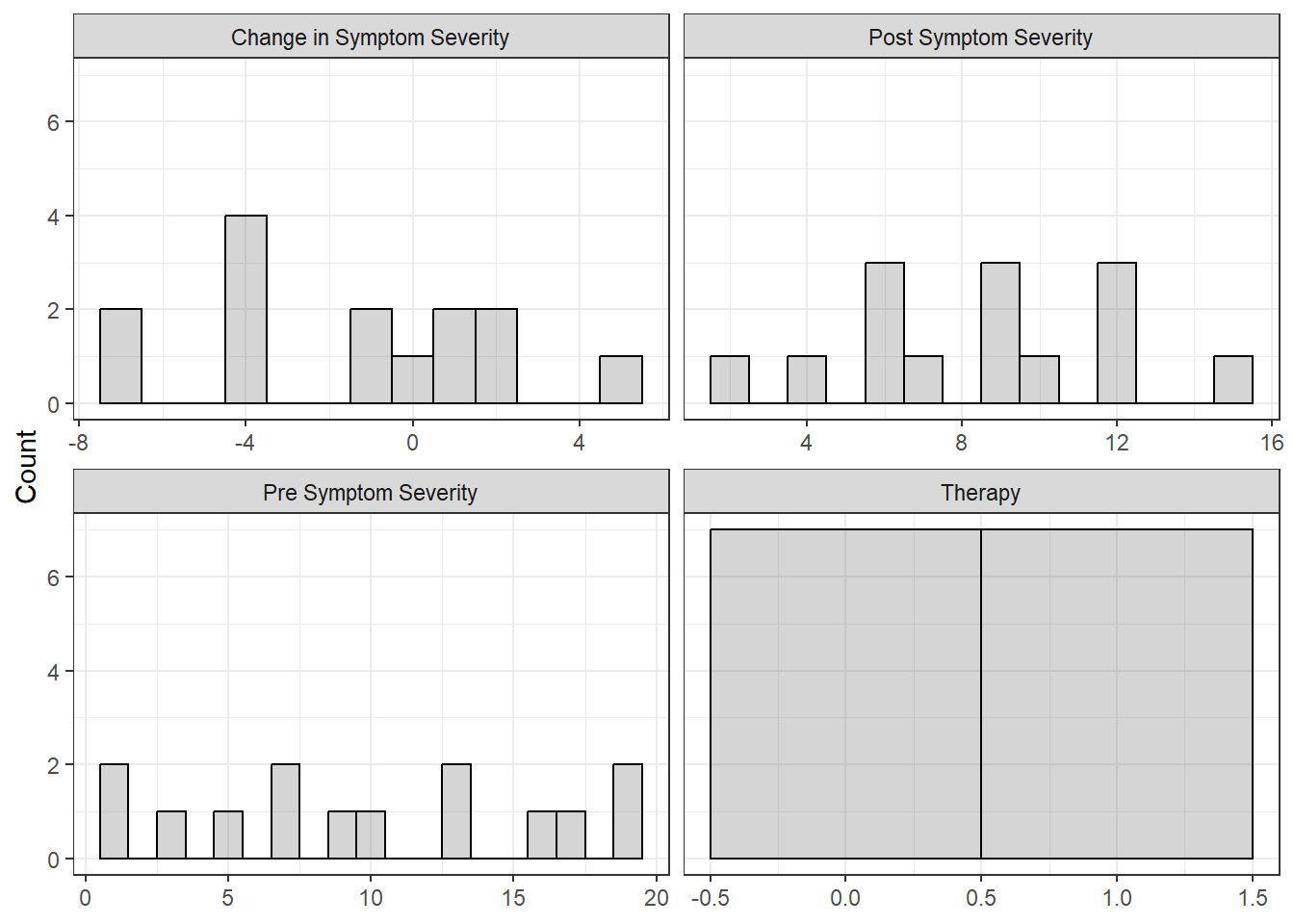
6.2.2.2 Bivariate
apaSupp::spicy_histos(df = df_ptsd,
var = pre_test,
split = therapy,
lab = "Symptom Severity Prior to Therapy") +
scale_x_continuous(breaks = seq(from = -24, to = 24, by = 2))
Figure 6.2
Distribution of Symptom Severity Prior to Therapy
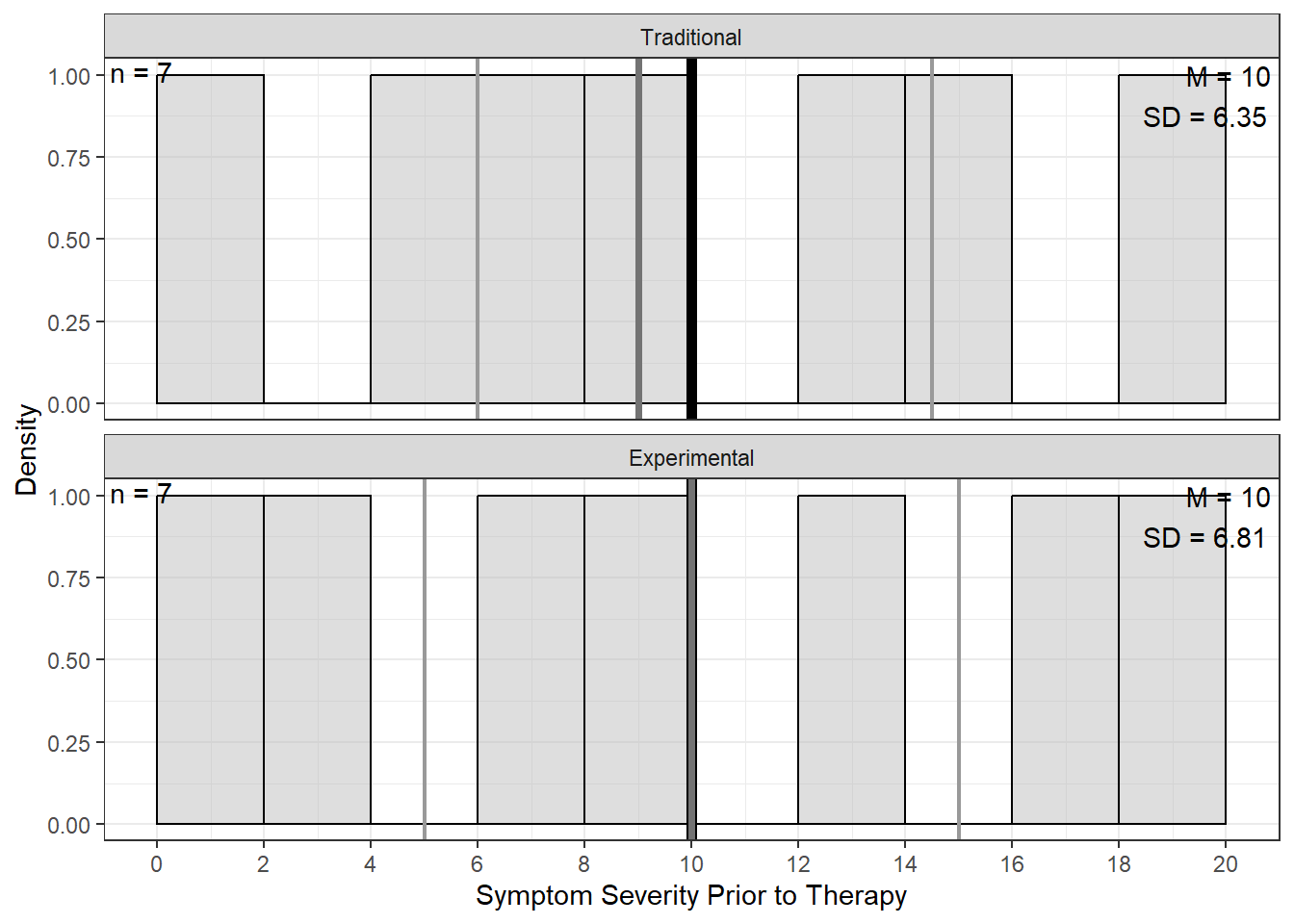
apaSupp::spicy_histos(df = df_ptsd,
var = post_test,
split = therapy,
lab = "Symptom Severity After Therapy") +
scale_x_continuous(breaks = seq(from = -24, to = 24, by = 2))
Figure 6.3
Distribution of Symptom Severity After Therapy
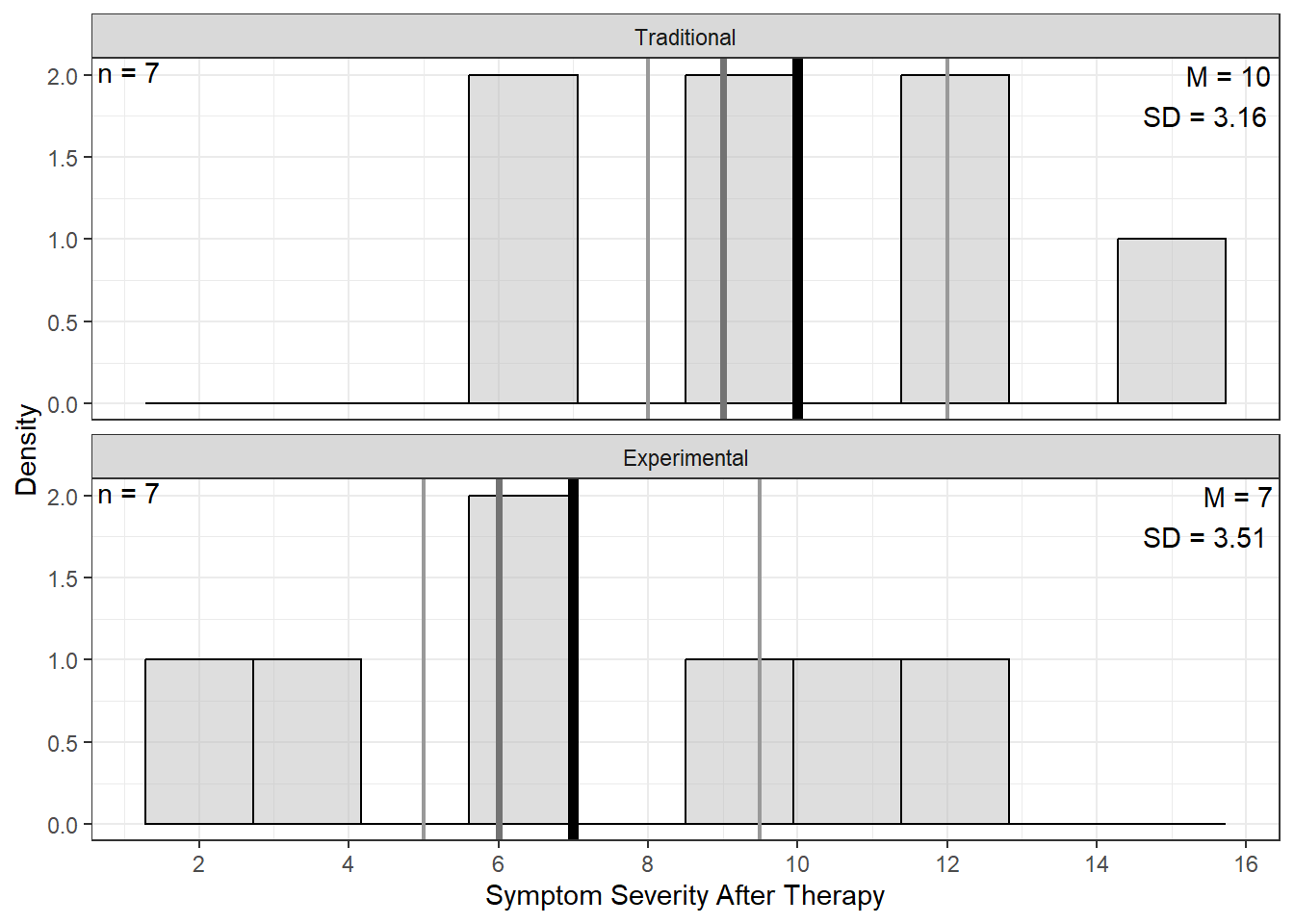
apaSupp::spicy_histos(df = df_ptsd,
var = gain,
split = therapy,
lab = "Change in Symptom Severity") +
scale_x_continuous(breaks = seq(from = -24, to = 24, by = 2))
Figure 6.4
Distribution of Change in Symptom Severity

df_ptsd_long %>%
ggplot(aes(x = time,
y = test,
group = id)) +
geom_point() +
geom_line() +
theme_bw() +
labs(x = NULL,
y = "Symptom Severity Score") +
facet_grid(~ therapy) +
stat_summary(aes(group = 1),
geom = "point",
fun = "mean",
shape = 13,
size = 5,
color = "red")+
stat_summary(aes(group = 1),
geom = "line",
fun = "mean",
color = "red",
linewidth = 1.5)
Figure 6.5
Progression in Symptom Severity, Stratified by Therapy
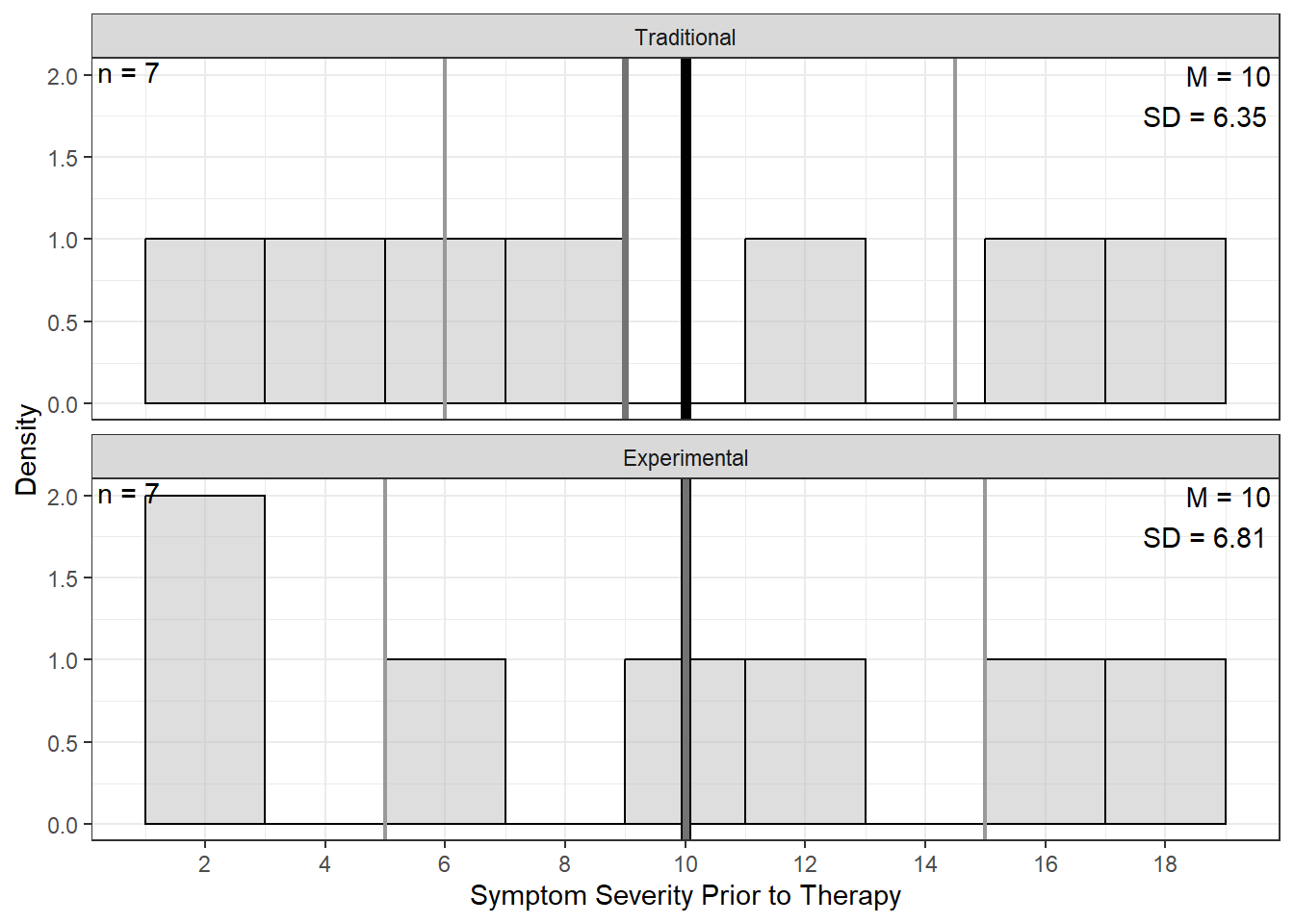
6.2.2.3 Multivariate
df_ptsd %>%
ggplot(aes(x = pre_test,
y = post_test)) +
geom_point(aes(color = therapy,
shape = therapy),
size = 3) +
theme_bw() +
geom_smooth(aes(color = therapy,
fill = therapy,
linetype = therapy),
method = "lm",
formula = y ~x,
alpha = .2) +
labs(x = "Observed Symptom Severity Prior to Therapy",
y = "Observed Symptom Severity\nAfter Therapy",
color = "Therapy Type:",
fill = "Therapy Type:",
shape = "Therapy Type:",
linetype = "Therapy Type:") +
theme(legend.position.inside = TRUE,
legend.position = c(0, 1),
legend.justification = c(-.1, 1.1),
legend.background = element_rect(color = "black"),
legend.key.width = unit(2, "cm")) +
scale_linetype_manual(values = c("solid", "longdash")) +
scale_x_continuous(breaks = seq(from = 0, to = 24, by = 2)) +
scale_y_continuous(breaks = seq(from = 0, to = 24, by = 2)) +
geom_abline(intercept = 0, slope = 1)
Figure 6.6
Association Between Symptom Severity Prior to and After Therapy, Stratified by Therapy Type
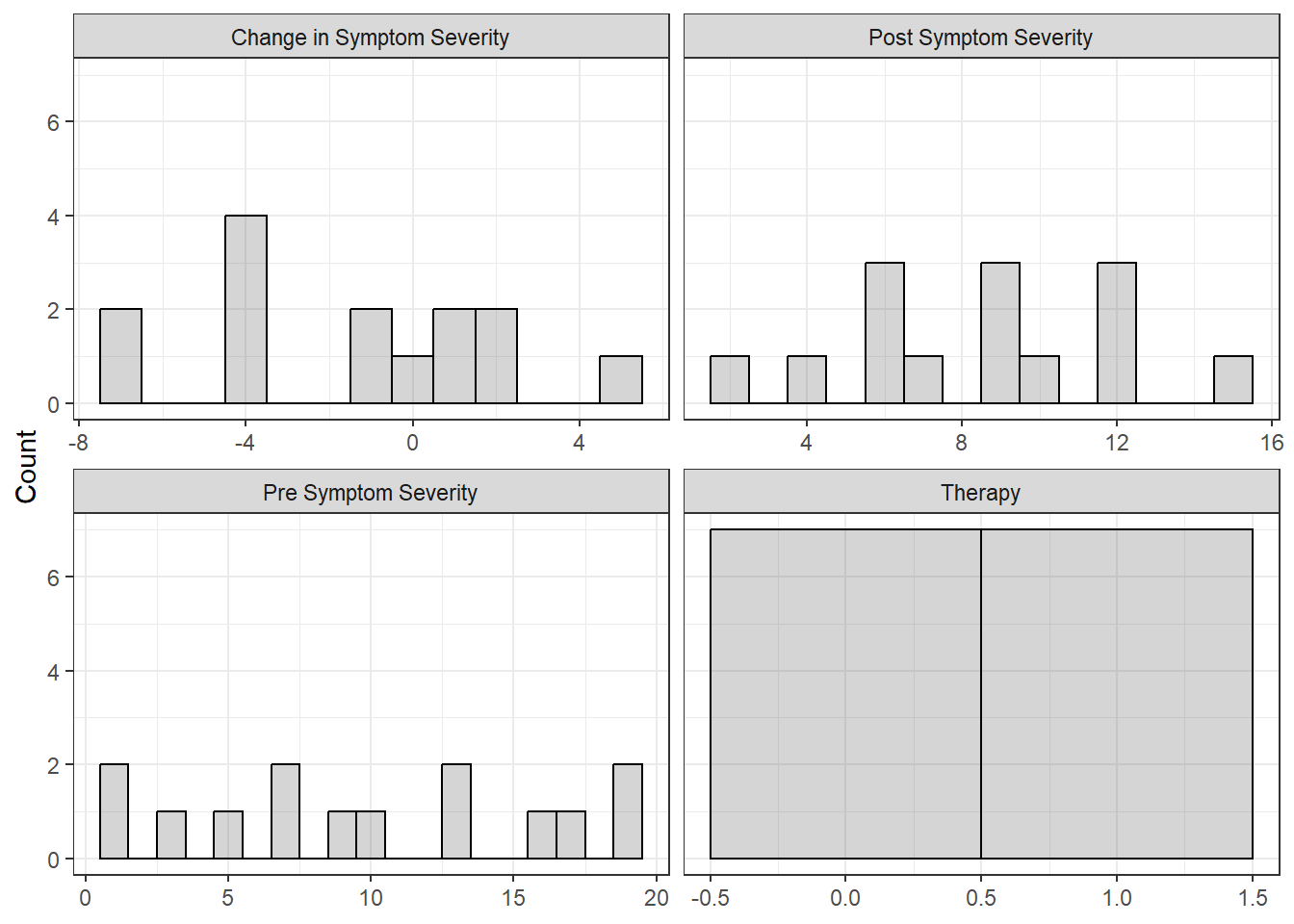
df_ptsd %>%
ggplot(aes(x = pre_test,
y = gain)) +
geom_point(aes(color = therapy,
shape = therapy),
size = 3) +
theme_bw() +
geom_smooth(aes(color = therapy,
fill = therapy,
linetype = therapy),
method = "lm",
formula = y ~x,
alpha = .2) +
labs(x = "Observed Symptom Severity Prior to Therapy",
y = "Observed Change in Symptom Severity",
color = "Therapy Type:",
fill = "Therapy Type:",
shape = "Therapy Type:",
linetype = "Therapy Type:") +
theme(legend.position.inside = TRUE,
legend.position = c(1, 1),
legend.justification = c(1.1, 1.1),
legend.background = element_rect(color = "black"),
legend.key.width = unit(2, "cm")) +
scale_linetype_manual(values = c("solid", "longdash")) +
scale_x_continuous(breaks = seq(from = 0, to = 24, by = 2))+
scale_y_continuous(breaks = seq(from = -24, to = 24, by = 2)) +
geom_hline(yintercept = 0)
Figure 6.7
Association Between Test Gain in Score and Pre-Test, Stratified by Therapy
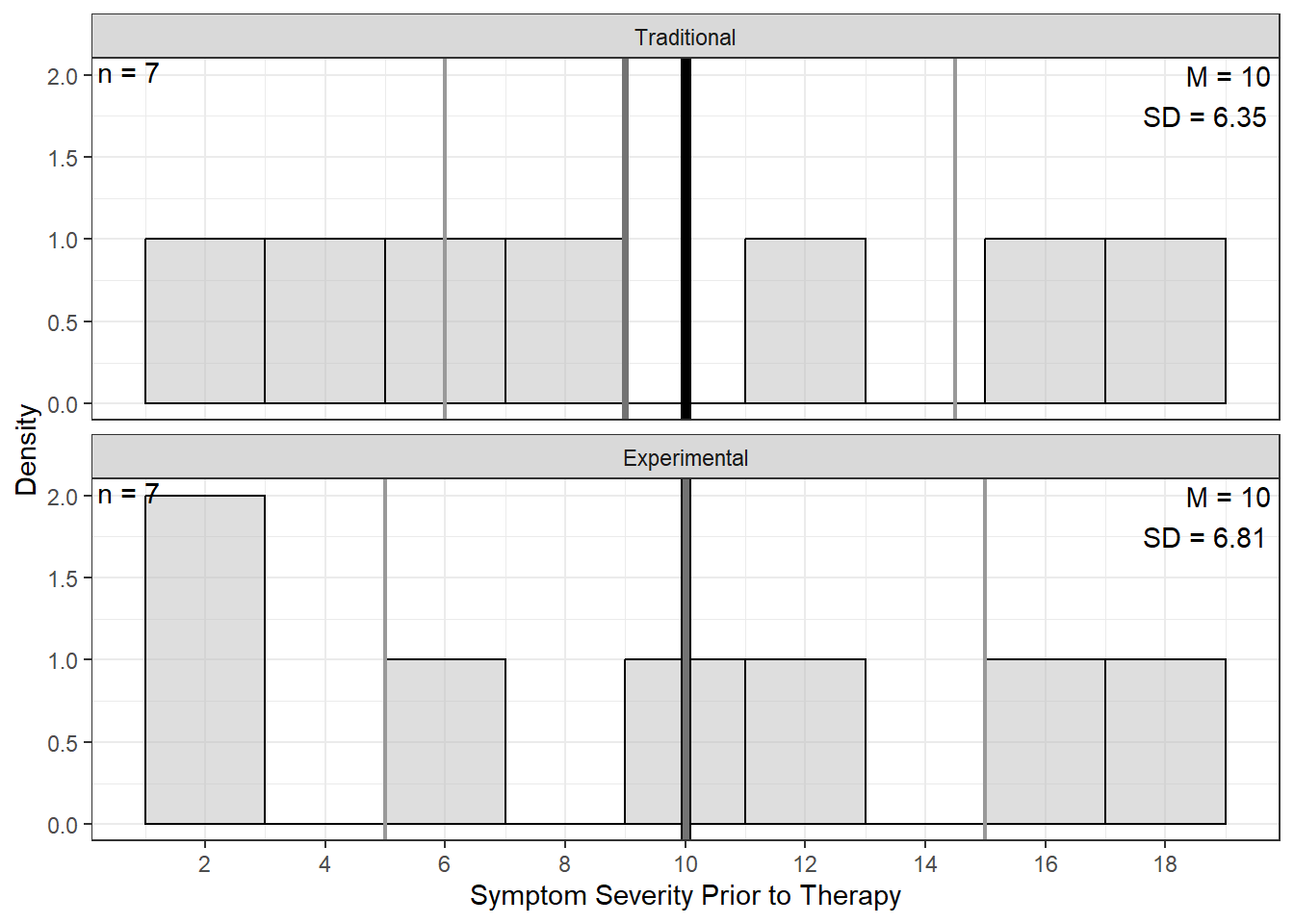
6.3 REGRESSION ANALYSIS
6.3.1 DV = Post Score, controlling for Pre Score
b | (SE) | p |
|
|
| |
|---|---|---|---|---|---|---|
(Intercept) | 5.02 | (0.39) | < .001*** | |||
pre_test | 0.50 | (0.03) | < .001*** | 0.88 | .779 | .963 |
therapy | .190 | .863 | ||||
Traditional | — | — | ||||
Experimental | -3.00 | (0.36) | < .001*** | |||
R² | .970 | |||||
Adjusted R² | .964 | |||||
Note. N = 14. = standardize coefficient; = semi-partial correlation; = partial correlation; p = significance from Wald t-test for parameter estimate. | ||||||
* p < .05. ** p < .01. *** p < .001. | ||||||
6.3.1.2 Role of Therapy
Test the significance for therapy: t(11) = -8.33, p <.001, VERY significant
After controlling for pre-test score, the experimental therapy is associated with 3 point lower post-test score compared to the traditional therapy, b = -3.00, SE = 0.36, p <.001.
Notes:
Covariate
pre_testhas b = -0.50, SE = 0.03, p <.001.The entire model: SSresid = 4.998, R^2 = .970, F(2, 11) = 176.6, p < .001
6.3.2 DV = Gain Score, ignoring Pre-Score
b | (SE) | p |
|
|
| |
|---|---|---|---|---|---|---|
(Intercept) | 0.00 | (1.27) | 1.000 | |||
therapy | .188 | .188 | ||||
Traditional | — | — | ||||
Experimental | -3.00 | (1.80) | .121 | |||
R² | .188 | |||||
Adjusted R² | .120 | |||||
Note. N = 14. = standardize coefficient; = semi-partial correlation; = partial correlation; p = significance from Wald t-test for parameter estimate. | ||||||
* p < .05. ** p < .01. *** p < .001. | ||||||
6.3.2.2 Role of Therapy
Test the significance for therapy: t(12) = -1.67, p = .121, NOT significant
No evidence was found that the therapy type was associated with a differential change in symptom severity,b = -3.00, SE = 1.80, p =.121.
Note:
The entire model: SSresid = 136, R^2 = .188, F(1, 11) = 2.78, p =.121
6.3.2.3 Equivalent Analysis: independent groups t-test
Welch Two Sample t-test
data: gain by therapy
t = 1.6672, df = 11.99, p-value = 0.1214
alternative hypothesis: true difference in means between group Traditional and group Experimental is not equal to 0
95 percent confidence interval:
-0.9210863 6.9210863
sample estimates:
mean in group Traditional mean in group Experimental
0 -3 6.3.3 DV = Gain Score, controlling for Pre-Score
b | (SE) | p |
|
|
| |
|---|---|---|---|---|---|---|
(Intercept) | 5.02 | (0.39) | < .001*** | |||
pre_test | -0.50 | (0.03) | < .001*** | -0.88 | .782 | .963 |
therapy | .188 | .863 | ||||
Traditional | — | — | ||||
Experimental | -3.00 | (0.36) | < .001*** | |||
R² | .970 | |||||
Adjusted R² | .965 | |||||
Note. N = 14. = standardize coefficient; = semi-partial correlation; = partial correlation; p = significance from Wald t-test for parameter estimate. | ||||||
* p < .05. ** p < .01. *** p < .001. | ||||||
6.3.3.2 Role of Therapy
Test the significance for therapy type on symptom severity change: t(11) = -8.33, p <.001, VERY significant
After controlling for symptom severity prior to therapy, the experimental therapy was associated with 3 point lower change on symptom severity after therapy compared to traditional therapy, b = -3.00, SE = 0.36, p <.001.
Notes:
Covariate
pre_testhas b = -0.50, SE = 0.03, p <.001.The entire model: SSresid = 4.998, R^2 = .970, F(2, 11) = 178.8, p < .001
6.3.4 Compare Models
| |||||||
|---|---|---|---|---|---|---|---|
Model | N | k | mult | adj | AIC | BIC | RMSE |
Model 1 | 14 | 3 | .970 | .964 | 33.31 | 35.87 | 0.60 |
Model 2 | 14 | 2 | .188 | .120 | 77.56 | 79.48 | 3.12 |
Model 3 | 14 | 3 | .970 | .965 | 33.31 | 35.87 | 0.60 |
Note. k = number of parameters estimated in each model. Larger values indicated better performance. Smaller values indicated better performance for Akaike's Information Criteria (AIC), Bayesian information criteria (BIC), and Root Mean Squared Error (RMSE). | |||||||
6.4 ALTERNATIVE ANALYSIS
6.4.1 2x2 mix ANOVA
Univariate Type III Repeated-Measures ANOVA Assuming Sphericity
Sum Sq num Df Error SS den Df F value Pr(>F)
(Intercept) 2395.75 1 586 12 49.0597 1.426e-05 ***
therapy 15.75 1 586 12 0.3225 0.5806
time 15.75 1 68 12 2.7794 0.1213
therapy:time 15.75 1 68 12 2.7794 0.1213
---
Signif. codes: 0 '***' 0.001 '**' 0.01 '*' 0.05 '.' 0.1 ' ' 1